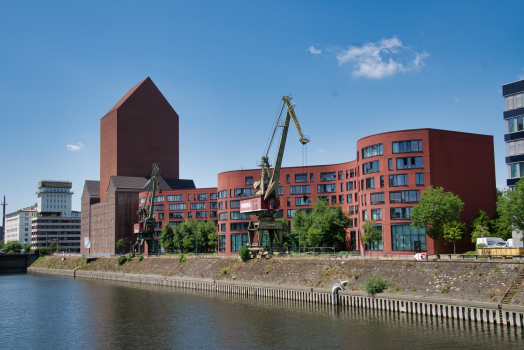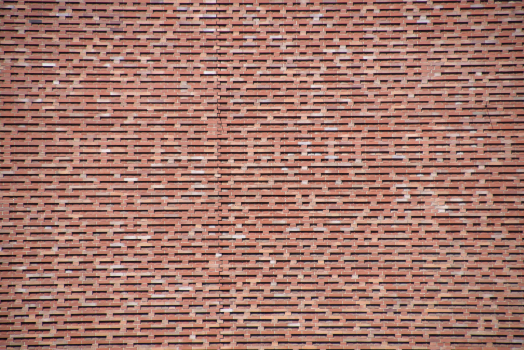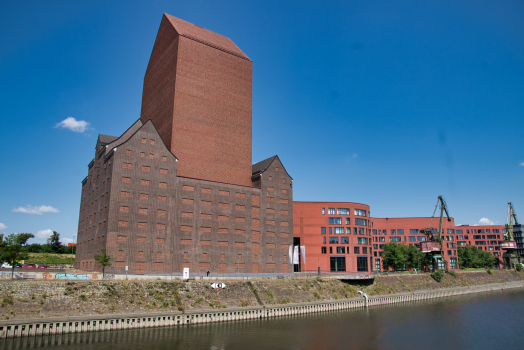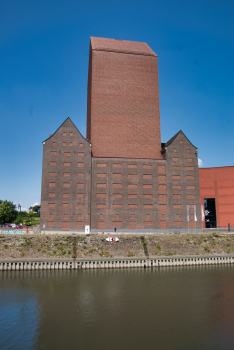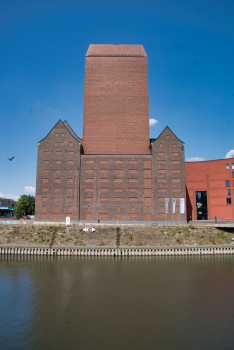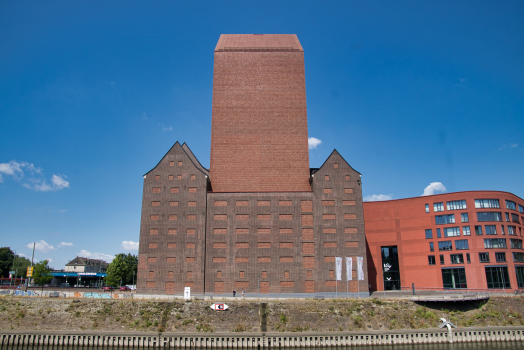General Information
| Status: | in use |
|---|
Project Type
| Function / usage: |
Archive |
|---|
Awards and Distinctions
| 2015 |
entry
for registered users |
|---|
Location
| Location: |
Duisburg, North Rhine-Westphalia, Germany |
|---|---|
| Address: | Schifferstraße 30 |
| Coordinates: | 51° 26' 14.03" N 6° 45' 29.17" E |
Technical Information
Dimensions
| gross floor area | 24 000 m² |
Case Studies and Applied Products
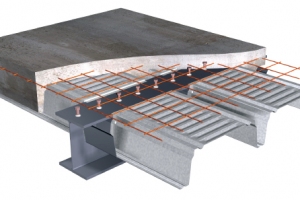
Composite floors - Cofrastra and Cofraplus
ArcelorMittal Construction offers several families of composite floors steel: Cofrastra and Cofraplus. Both are suitable for use in new and existing buildings.
[more]New NRW State Archives in Duisburg
For the restructuring of the interior harbor of Duisburg – a harbor area that lay idle for several decades – British architect Norman Foster developed a master plan. Since then several reputable architects have implemented new buildings there and contributed to the esthetic and urban upgrade that is breathing new life into the area once again.
A red brick building was chosen for the new state archives – a former granary built in the 1930s – from which a 76-meter high, windowless archive tower protrudes. The complex also includes an expansion using a 160 meter-long, undulating structure.
With an archive utility area of 23,000 m² and approximately 148 kilometers of shelf space, the state archives of North Rhine Westphalia is Germany’s largest archive building at the time of its completion. In addition to the warehousing of documents, deeds and dossiers of several decades, the archive also incorporates a reading hall and a museum as well as offices.
Contractor's Task
Europe's largest archive building is located in the port of Duisburg: a listed former silo building from the 1930s has been converted and extended. The North Rhine-Westphalia state archive is to take over, index, preserve, research and publish documents and make them accessible for use by third parties. The aim is to minimize lifecycle costs, using sustainable materials, and optimize energy efficiency. At the same time, the building is not only intended to mark the entrance to the old town, but also to represent a landmark for the entire Ruhr region. At this exposed location, both a significant, landmark building and a sensitive integration of the new building into the existing structural substance are required: in the revitalization of the warehouse building into a building meeting modern requirements for the "storage" of the archives, the potential and charm of the substance must be awakened and carefully supplemented by a new building wing to form a harmonious ensemble.
Description of the main supporting structure
Already in the competition design, the architects of O&O Baukunst, together with the engineers of osd, developed the central idea of building a "warehouse in the warehouse" and integrating the new building as a tower structure into the existing warehouse building. In the course of planning, the choice of the archive system increased the deformation limits to l/1000: instead of the originally envisaged pure reinforced concrete structure, the supporting structure was divided into an outer reinforced concrete tower, which transfers the horizontal loads and assumes the function of the building envelope, and an inner steel structure to transfer the archive loads and comply with the high deformation limits.
Choice of building materials
Unlike an internal reinforced concrete structure, which is subject to time- and load-dependent changes in shape due to shrinkage and creep, the deformations in a steel structure can be predicted much more accurately and the high requirements can be ensured with correspondingly greater certainty. In addition, the design of the steel structure included the installation of hydraulic presses to allow for subsequent readjustment.
The building accommodates archives in shelves with a total length of 148 kilometers, it permanently preserves the documents of the state of NRW and is consistently designed for stability of the climate system and conservation of resources. The long-term intended archiving is taken into account with a robust building designed for durability.
Explanation of the design
An archive tower was added to the existing storage building in the center. The state's archival materials can now be concisely housed in a visible manner. The openings and the roof areas of the existing storage facility were closed. The basic design element is a solid outer skin made of bricks, which gives the archive tower a sculptural appearance. The technically required façade elements, such as drainage channels, façade safety devices, are designed in such a way that they visually recede into the background. The historic structure and function of the monument remain legible. The color and texture of the new bricks echo the original surface of the existing bricks, which bear witness to Duisburg's industrial history through their patina. Projections and recesses in the brickwork create a finely structured ornamentation.
Special engineering achievement
In order to transfer the loads from the new tower structure into the building ground, the architects and engineers worked closely together to develop a load transfer system that was independent of the existing building. For this purpose, a pyramid-shaped transition structure was designed on the 6th floor, which transfers the loads from the steel columns of the tower structure to so-called "Vierendeel columns". Although these Vierendeel columns formally enclose the existing reinforced concrete columns, they are not statically connected to them, but transfer the loads of the archive tower directly - past the existing columns - into the floor slab. This prevents uneven settlements and misalignments. The joint foundation of the existing storage building and the tower structure was designed as a so-called combined pile and slab foundation. For this purpose, 500 micropiles of up to 12m in length were first installed in the existing basement. Subsequently, the basement was completely filled with concrete and designed as a new reinforced concrete floor slab, which absorbs the old and the new loads.
What are the positive effects of this particular engineering achievement?
"On the design of engineering structures, or the art of building is indivisible," reads an article by Jörg Schlaich in Bauingenieur 2/1986, in which he writes that all building is architecture, regardless of who does it, architects, engineers or even laymen. Good architecture, however, could only thrive if architects and engineers worked together.
The new construction of the archive tower of the NRW state archive impressively demonstrates that high design quality is the result of joint motivation and consistent cooperation between architects and engineers. The project has shown that only in teamwork between architects and engineers can an aesthetic added value arise from the mere implementation of construction techniques and a building become architectural art.
The NRW State Archive was awarded the 2014 Balthasar Neumann Prize.
Explanatory report by office for structural design osd GmbH & Co. KG for submission to the Ulrich Finsterwalder Ingenieurbaupreis 2015
Participants
Relevant Web Sites
There currently are no relevant websites listed.
- About this
data sheet - Structure-ID
20066055 - Published on:
24/03/2014 - Last updated on:
02/08/2023

